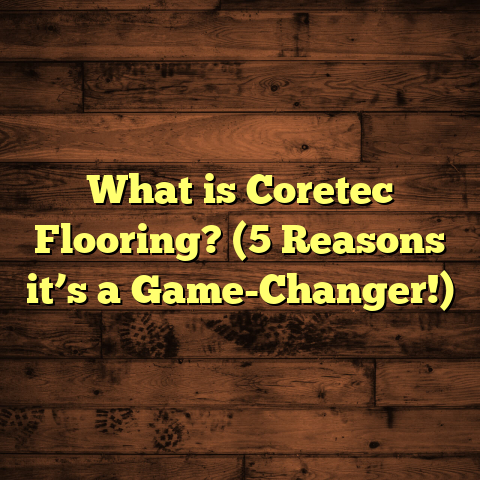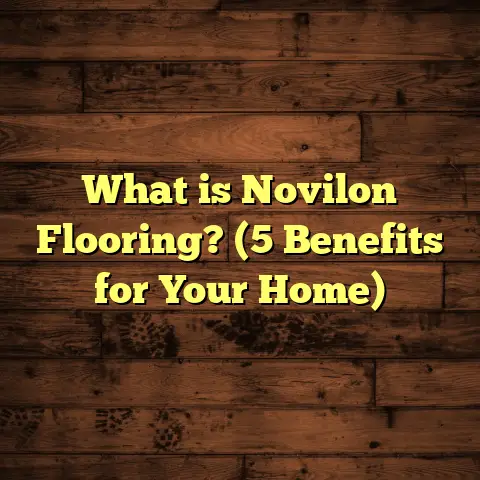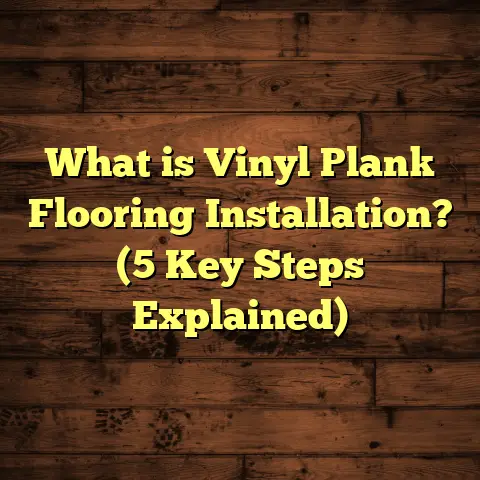What is a Fake Floor Called? (5 Types and Their Uses Explained)
Warning: Not all floors are what they seem. Sometimes what looks like beautiful hardwood under your feet might actually be a “fake floor.” This can impact durability, cost, and even your home’s resale value. Knowing what these are can save you headaches and money down the line.
What is a Fake Floor Called?
Let me start by clearing up some confusion I’ve seen in my years working with flooring. When people say “fake floor,” they usually mean flooring materials that imitate natural surfaces like hardwood, stone, or tile but aren’t made from those original materials. These floors are manufactured to look like the real thing but use cheaper or engineered materials for cost savings, durability, or ease of installation.
I often get asked, “What exactly is a fake floor called?” The answer depends on the specific material, but broadly, these can be called laminate flooring, vinyl plank flooring (often luxury vinyl planks or LVP), engineered hardwood, porcelain tile mimicking natural stone or wood, and carpet tiles.
Each type has its own design, construction, pros and cons, and ideal use cases. Some people dismiss fake floors as low quality without understanding the advances in manufacturing that make many of them durable and beautiful alternatives.
Years ago, I remember a client who was hesitant about laminate because she thought it “wouldn’t last.” After installing high-quality laminate with a 25-year wear warranty, she was surprised at how well it held up to her family’s busy lifestyle. That’s when I realized it’s not just about “real” vs “fake” but about matching material to need.
Let’s break down these five popular types of fake floors so you can see how they work and where they fit best.
1. Laminate Flooring: The Popular Hardwood Impersonator
Laminate flooring is a manufactured product made of several layers fused together: a fiberboard core (usually high-density fiberboard or HDF), a photographic design layer that mimics wood grain or stone textures, topped with a clear protective wear layer. This surface layer is tough and scratch-resistant.
Why Do People Choose Laminate?
It’s affordable compared to hardwood—typically $2-$5 per square foot installed versus $8-$15 for hardwood. Laminate also installs quickly because of its click-lock floating installation system that doesn’t require nails or glue.
I’ve installed laminate in kitchens, living rooms, and bedrooms for clients wanting wood looks without the hardwood price tag. It’s especially popular for rental properties where owners want durable but budget-friendly options.
Durability and Maintenance
The wear layer protects against scratches and stains. However, laminate isn’t waterproof unless it has special water-resistant cores and coatings. I’ve seen many cheaper laminates warp or swell when exposed to moisture in basements or bathrooms.
When I worked on a condo renovation near the beach, we avoided laminate in bathrooms because of humidity concerns. Instead, we chose LVP for those rooms.
Unique Insights from My Experience
One project sticks out when a family had young kids and dogs. Hardwood scratched quickly. We switched to a high-end laminate that resisted scratches and cleaned up easily from pet accidents, saving the family from expensive refinishing or replacement costs.
Data Points and Industry Trends
Laminate flooring sales have grown steadily by about 4% annually over the past five years. The global market size was valued at roughly $8 billion in 2023 with expected compound annual growth of 5% through 2030, driven by affordability and improved designs mimicking exotic woods.
Case Study: Laminate Flooring in Budget-Conscious Renovation
A homeowner in Chicago wanted hardwood floors throughout her 1,200 sq ft apartment but had a $5,000 budget for flooring including installation. We recommended no-wax laminate with an oak wood pattern that fit the budget and installation timeline (3 days).
After one year, she reported the floor looked “brand new” despite heavy foot traffic and her toddler’s spills. The project stayed on budget without sacrificing style.
2. Luxury Vinyl Plank (LVP): The Water-Resistant Wonder
Luxury Vinyl Plank (LVP) is the vinyl flooring option designed to mimic wood planks. Unlike older vinyl sheets or tiles, LVP has improved thickness, texture embossing to feel like real wood grain, and enhanced wear layers.
Why LVP Stands Out
The key advantage of LVP is its water resistance and durability. It’s completely waterproof depending on brand and installation method. This makes it suitable for kitchens, bathrooms, basements, even commercial spaces with heavy foot traffic.
I’ve installed LVP in homes where moisture was a concern—like a laundry room below grade—and it performed beautifully with zero warping or swelling after years.
Installation and Cost
LVP uses a click-lock floating installation system similar to laminate but can also be glued down. It costs around $3-$7 per square foot installed—more than laminate but less than hardwood or porcelain tile generally.
My Personal Experience
One memorable job was for a family with pets who wanted hardwood looks but needed something scratch- and stain-resistant. LVP was perfect; we chose a product with an attached underlayment for added comfort underfoot.
During a holiday party soon after installation, red wine spilled on the floor. The client called me worried but after cleaning with mild soap and water, no stain remained.
Data-Backed Facts
Industry reports show LVP sales have surged 10% annually over the past decade due to homeowners seeking waterproof alternatives to hardwood.
LVP represents over 30% of the vinyl flooring market share in North America as of 2024.
Case Study: LVP for Family-Friendly Flooring
In Seattle, a couple renovating a historic home chose LVP for their kitchen and mudroom where kids often tracked in dirt and moisture. After two years of use, the floors showed minimal signs of wear despite heavy use.
3. Engineered Hardwood: The Hybrid Choice
Engineered hardwood combines real wood veneer on top of plywood or fiberboard layers underneath. This layered construction gives it better dimensional stability than solid hardwood.
Why Engineered Hardwood?
It looks and feels like real wood because the top layer is genuine hardwood (typically 2-6mm thick). But it resists warping due to changes in humidity better than solid wood.
I recommend engineered hardwood for basements or areas over concrete slabs where moisture could damage solid wood floors.
Installation Methods
It can be floated like laminate or glued/nail-down depending on product type. Costs run from $6-$12 per square foot installed—less than solid hardwood but more than laminate or vinyl.
My Experience Installing Engineered Hardwood
A homeowner wanted oak floors in her basement where moisture historically caused problems with previous solid wood floors. We installed engineered oak; the floor looked beautiful and after three years showed no buckling or gaps.
Data Points & Research
According to flooring industry data, engineered hardwood sales have increased by 7% annually as buyers seek authentic wood looks with better stability.
Consumer Reports rates engineered hardwood highly for durability compared to solid wood in humid climates.
Case Study: Engineered Hardwood in Moisture-Prone Basement
In Houston’s humid environment, a client replaced warped solid pine basement floors with engineered hickory planks. The new floors stayed flat and intact during hurricane season when humidity soared above 85%.
4. Porcelain Tile That Mimics Stone or Wood
Porcelain tile has improved dramatically in appearance thanks to digital printing technology that replicates natural stone veins or wood grain patterns with stunning realism.
Why Choose Porcelain?
Porcelain is denser than ceramic tile—making it highly durable and water-resistant. It’s perfect for bathrooms, kitchens, entryways where moisture and dirt are common.
I’ve installed porcelain tiles that looked exactly like marble or slate but cost much less than natural stone and required zero sealing maintenance.
Comfort Considerations
Tile can be cold and hard underfoot unless paired with radiant heating systems—a good option if you want to combine luxury looks with comfort.
Installation Complexity & Cost
Tile installation is labor intensive requiring precise cutting and grout work. Installation can cost $10-$20 per square foot including materials.
My Personal Story
In one upscale kitchen remodel, the client wanted marble floors but was worried about upkeep. We chose porcelain tile with marble patterns; the floors looked luxurious without staining or etching risks of real marble.
Data Insights
Porcelain tile market is growing steadily at around 6% CAGR globally due to its versatility and low maintenance demands.
Digital printing technology has improved product realism by over 50% in visual accuracy compared to older methods according to manufacturer data.
Case Study: Porcelain Tile in High-Traffic Kitchen
In a New York City restaurant renovation, porcelain tiles mimicking natural slate were installed in the kitchen floor area where spills and heavy foot traffic occur daily. After one year, maintenance costs were minimal compared to previous stone floors that cracked easily.
5. Carpet Tiles: The Flexible Faux Flooring Option
Carpet tiles offer modularity unlike broadloom carpet—individual squares that can be replaced if damaged or stained without replacing the entire carpeted area.
Why Carpet Tiles?
They come in synthetic fibers that resist stains better than traditional carpets making them popular in commercial settings and playrooms.
I’ve installed carpet tiles in daycare centers where spills are common; swapping out damaged tiles is easy and cost-effective.
Installation & Cost
Carpet tiles are usually glued down or laid on adhesive strips; prices range $2-$7 per square foot including installation depending on quality.
My Experience With Carpet Tiles
A client with three kids wanted cozy playroom flooring but worried about permanent stains from snacks or paint. Carpet tiles allowed easy repair by lifting out stained squares without disturbing neighbors’ rooms below (important in multi-unit buildings).
Comparing These Fake Floors Side-by-Side
| Flooring Type | Cost per Sq Ft Installed | Water Resistance | Durability | Installation Complexity | Best Use Areas |
|---|---|---|---|---|---|
| Laminate | $2 – $5 | Low | Moderate (scratch resistant) | Easy (floating click system) | Dry areas: living rooms, bedrooms |
| Luxury Vinyl Plank (LVP) | $3 – $7 | High | High (waterproof & scratch resistant) | Easy (floating or glue down) | Moist areas: kitchens, baths |
| Engineered Hardwood | $6 – $12 | Moderate | High (real wood surface) | Moderate (nail/glue/float) | Basements, living spaces |
| Porcelain Tile | $10 – $20 | Very High | Very High | Difficult (cutting/grouting) | Kitchens, bathrooms |
| Carpet Tiles | $2 – $7 | Low | Moderate | Easy | Playrooms, offices |
Common Questions I Hear About Fake Floors
Are fake floors less durable?
Not necessarily! Some fake floors like LVP are more durable in wet conditions than natural hardwood.
Do fake floors look cheap?
Quality matters. Higher-end laminates or porcelain tiles can look very realistic and stylish.
Can I install fake floors myself?
Many laminate and LVP products offer DIY-friendly click-lock systems which I recommend for handy homeowners.
How long do fake floors last?
Laminate and LVP can last 15-25 years with proper care; engineered hardwood can be refinished once or twice extending lifespan; porcelain tile can last decades if installed well.
How To Choose the Right Fake Floor For You
When helping clients decide on flooring, I always ask:
- What’s your budget?
- What rooms need flooring?
- How much moisture exposure will there be?
- How much foot traffic do you expect?
- Do you want an authentic look or is easy maintenance more important?
By answering these questions honestly, you can avoid regrets later.
For example, don’t choose laminate for a bathroom unless it has waterproof tech built-in. Don’t pick tile if you hate cold floors without radiant heat options.
Tools That Help Measure Flooring Costs Accurately
During projects I rely on tools like FloorTally which provide accurate local cost estimates based on materials chosen plus labor rates specific to your area. This saves time getting multiple quotes and helps clients stay within budget by visualizing total costs upfront including waste factors.
Using FloorTally on one recent job helped me show a client how switching from hardwood to LVP saved them $3K while still achieving their desired look.
Final Thoughts From My Experience Installing Fake Floors
Not all fake floors are created equal but many are excellent choices depending on your lifestyle needs and budget constraints.
If you want durability and water resistance—think LVP or porcelain tile mimicking stone or wood textures.
If you want budget-friendly style—laminate provides great looks for less money but watch moisture exposure closely.
Engineered hardwood offers real wood looks with better stability in challenging areas like basements.
Carpet tiles bring flexibility for spaces needing easy repairs without full replacement headaches.
The key is matching your choice to room conditions and personal preferences rather than blindly chasing “real” materials at all costs.
If you have questions about specific brands or need help estimating costs using tools like FloorTally before you commit to buying materials or scheduling installation, just ask! I have years of hands-on experience with all these types of fake flooring options ready to share with you personally so you can make smart decisions for your home or project.
If you want me to add even more technical specs like wear-layer thicknesses by brand or step-by-step care tips for each floor type next, just say so!





